Assessing the Impact of Recycled Water Quality and Clogging on Infiltration Rates at A Pioneering Soil Aquifer Treatment (SAT) Site in Alice Springs, Northern Territory (NT), Australia
Abstract
:1. Introduction
2. Materials and Methods
2.1. Study Site and Operations
2.2. Infiltration Rate
2.3. Water Quality
2.4. Sediment Sampling
3. Results and Discussion
3.1. Recharge Water and Groundwater Quality
3.2. Soil Characteristics
3.3. Hydraulic Performance
4. Conclusions
Acknowledgments
Author Contributions
Conflicts of Interest
Abbreviations
| AHD | Australian height datum |
| ANAMMOX | Anaerobic Ammonium Oxidation |
| AZRI | Arid Zone Research Institute |
| BDOC | Biodegradable dissolved organic carbon |
| BOD | biological oxygen demand |
| CSIRO | Commonwealth Scientific and Industrial Research Organisation |
| DAF | dissolved air flotation |
| DAFF | dissolved air flotation and filtration |
| DO | dissolved oxygen |
| DOC | dissolved organic carbon |
| EC | electrical conductivity |
| MAR | managed aquifer recharge |
| NT | Northern Territory |
| PVC | polyvinyl chloride |
| PWC | Power and Water Corporation |
| SAT | Soil Aquifer Treatment |
| SCADA | supervisory control and data acquisition |
| TOC | total organic carbon |
| TSS | total suspended solids |
| WRP | water reclamation plant |
References
- Dillon, P.; Pavelic, P.; Page, D.; Beringen, H.; Ward, J. Managed Aquifer Recharge: An Introduction; Waterlines Report Series No. 13; National Water Commission: Canberra, Australia, 2009.
- Fox, P.; Houston, S.; Westerhoff, P.; Drewes, J.E.; Nellor, M.; Yanko, B.; Baird, R.; Rincon, M.; Arnold, R.; Lansey, K.; et al. An Investigation of Soil Aquifer Treatment for Sustainable Water Reuse; AWWA Research Foundation and American Water Works Association: Denver, CO, USA, 2001. [Google Scholar]
- Parsons, S.; Dillon, P.; Irvine, E.; Hollard, G.; Kaufman, C. Progress in Managed Aquifer Recharge in Australia; Waterlines Report Series No. 73; National Water Commission: Canberra, Australia, 2012.
- Hutchinson, A.; Milczarek, M.; Banerjee, M. Clogging phenomena related to surface water recharge facilities. In Clogging Issues Associated with Managed Aquifer Recharge Methods; Martin, R., Ed.; IAH Commission on Managing Aquifer Recharge: Reading, UK, 2013; pp. 34–49. Available online: https://recharge.iah.org/working-groups/clogging-and-its-management (accessed on 2 March 2017).
- Rinck-Pfeiffer, S.; Dillon, P.; Ragusa, S.; Hutson, J.; Fallowfield, H.; de Marsily, G.; Pavelic, P. Reclaimed water for aquifer storage and recovery: A column study of well clogging. In Clogging Issues Associated with Managed Aquifer Recharge Methods; Martin, R., Ed.; IAH Commission on Managing Aquifer Recharge: Reading, UK, 2013; pp. 26–33. Available online: https://recharge.iah.org/working-groups/clogging-and-its-management (accessed on 2 March 2017).
- Houston, S.L.; Duryea, P.D.; Hong, R. Infiltration considerations for ground-water recharge with waste effluent. J. Irrig. Drain. Eng. 1999, 125, 264–272. [Google Scholar] [CrossRef]
- Escalante, F.; Enrique, A. Practical Criteria in the Design and Maintenance of MAR Facilities in order to minimize clogging impacts obtained from two different operative sites in Spain. In Clogging Issues Associated with Managed Aquifer Recharge Methods; Martin, R., Ed.; IAH Commission on Managing Aquifer Recharge: Reading, UK, 2013; pp. 26–33. Available online: https://recharge.iah.org/working-groups/clogging-and-its-management (accessed on 2 March 2017).
- Pavelic, P.; Dillon, P.J.; Barry, K.E.; Vanderzalm, J.L.; Correll, R.L.; Rinck-Pfeiffer, S.M. Water quality effects on clogging rates during reclaimed water ASR in a carbonate aquifer. J. Hydrol. 2007, 334, 1–16. [Google Scholar] [CrossRef]
- Breton, M. Alice Springs Soil Aquifer Treatment; Operational Review and Hydraulic Performance. Master’s Thesis, University of Technology, Sydney, Australia, 2009. [Google Scholar]
- Racz, A.J.; Fisher, A.T.; Schmidt, C.M.; Lockwood, B.S.; Los Huertos, M. Spatial and Temporal Infiltration Dynamics during Managed aquifer Recharge; Ground Water 50, No. 4; National Ground Water Association: Malden, MA, USA, 2012; pp. 562–570. [Google Scholar]
- Grischek, T.; Schubert, J.; Jasperse, J.L.; Stowe, S.M.; Collins, M.R. What is the appropriate site for RBF? In Proceedings of the 6th International Symposium on Managed Aquifer Recharge, Phoenix, AZ, USA, 29 October–2 November 2007.
- Peyton, D. Modified recharge basin floors to control sediment and maximize infiltration efficiency. In Management of Aquifer Recharge for Sustainability, Proceedings of the 4th International Symposium on Managed Aquifer Recharge, Adelaide, South Australia, 22–26 September 2002; Dillon, P., Ed.; August Aimé Balkema: Lisse, The Netherlands, 2002. [Google Scholar]
- Vanderzalm, J.L.; Dillon, P.J.; Tapsuwan, S.; Pickering, P.; Arnold, N.; Bekele, E.B.; Barry, K.E.; Donn, M.J.; McFarlane, D. Economics and Experiences of Managed Aquifer Recharge (MAR) with Recycled Water in Australia; Australian Water Recycling Centre of Excellence: Brisbane, QLD Australia, 2015. [Google Scholar]
- Barry, K.; Vanderzalm, J.; Bekele, E.; Donn, M.; Miotlinski, K.; Dillon, P. Assessing infiltration rates and clogging impacts during recycled water managed aquifer recharge (MAR) in Floreat (WA) and Alice Springs (NT), Australia. In Proceedings of the 9th International Symposium on Managed Aquifer Recharge, Mexico City, Mexico, 20–24 June 2016.
- Bekele, E.B.; Donn, M.J.; Barry, K.E.; Vanderzalm, J.L.; Kaksonen, A.H.; Puzon, G.J.; Wylie, J.; Miotlinski, K.; Cahill, K.; Walsh, T.; et al. Managed Aquifer Recharge and Recycling Options (MARRO): Understanding Clogging Processes and Water Quality Impacts; Australian Water Recycling Centre of Excellence: Brisbane, QLD, Australia, 2015. [Google Scholar]
- Knapton, A.; Jolly, P.; Pavelic, P.; Pavelic, P.; Dillon, P.; Barry, K.; Mucha, M.; Gates, W. Feasibility of a Pilot 600 ML/yr Soil Aquifer Treatment Plant at the Arid Zone Research Institute; Department of Infrastructure Planning and Environment Technical Report 29/2004; Northern Territory Government: Palmerston, NT, Australia, 2004.
- Quinlan, T.; Woolley, D.R. Geology and Hydrology, Alice Springs Town and Inner Farm Basins, Northern Territory; Bulletin 89; Department of Natural Development, Bureau of Mineral Resources, Geology and Geophysics: Canberra, ACT, Australia, 1969.
- Berry, K. Monitoring Development Alice Springs Commonage; WRD910002; NT Government, Power and Water Authority, Water Resources Branch: Darwin, NT, Australia, 1991.
- Miotliński, K.; Barry, K.; Dillon, P.; Breton, M. Alice Springs Soil Aquifer Treatment Project—Hydrological and Water Quality Monitoring 2008–2009 Report; Water for a Healthy Country Flagship Report; Commonwealth Scientific Industrial Research Organisation (CSIRO): Canberra, ACT, Australia, 2010. [Google Scholar]
- Wischusen, J.D.H. Alice Springs Soil Aquifer Treatment Scheme: Construction and Sampling of Monitoring Bores 2006; NT-NRETA Water Resources Branch Report 26/2007A; Northern Territory Government, Department of Natural Resources, Environment and the Arts: Alice Springs, NT, Australia, 2007.
- Pavelic, P.; Dillon, P.J.; Mucha, M.; Nakai, T.; Barry, K.E.; Bestland, R. Laboratory assessment of factors affecting soil clogging of soil aquifer treatment systems. Water Res. 2011, 45, 3153–3163. [Google Scholar] [CrossRef] [PubMed]
- Abel, C.D.T.; Sharma, S.; Lamolo, Y.N.; Maeng, S.K.; Kennedy, M.D.; Amy, G.L. Attenuation of Bulk Organic Matter, Nutrients (N and P), and Pathogen indicators During Soil Passage: Effect of Temperature and Redox Conditions in Simulated Soil Aquifer Treatment (SAT). Water Air Soil Pollut. 2012, 223, 5205–5220. [Google Scholar] [CrossRef]
- Gates, W.; Janik, L.; Pavelic, P.; Dillon, P.; Barry, K. Characterisation of the Physical and Geochemical Properties and Infrared Spectra of Five Soil Cores at the AZRI Site near Alice Springs, Northern Territory; CSIRO Water for a Healthy Country Flagship Report; Commonwealth Scientific Industrial Research Organisation (CSIRO): Canberra, ACT, Australia, 2009. [Google Scholar]
- McDonald, R.C.; Isbell, R.F.; Speight, J.G.; Walker, J.; Hopkins, M.S. Australian Soil and Land Survey Handbook; Commonwealth Scientific Industrial Research Organisation (CSIRO): Canberra, ACT, Australia, 1990. [Google Scholar]
- Pérez-Paricio, A. Integrated Modelling of Clogging Processes in Artificial Groundwater Recharge. Ph.D. Thesis, Technical University of Catalonia (UPC), Barcelona, Spain, 2000. [Google Scholar]
- Unpublished Data—to Be Published in CSIRO Data Access Portal. Available online: http://hdl.handle.net/102.100.100/25155 (accessed on 28 February 2017).
- Bouwer, H.; Rice, R.C.; Lance, J.C.; Gilbert, R.G. Rapid-infiltration research at Flushing Meadows Project, Arizona. Water Pollut. Control Fed. 1980, 52, 2457–2470. [Google Scholar]
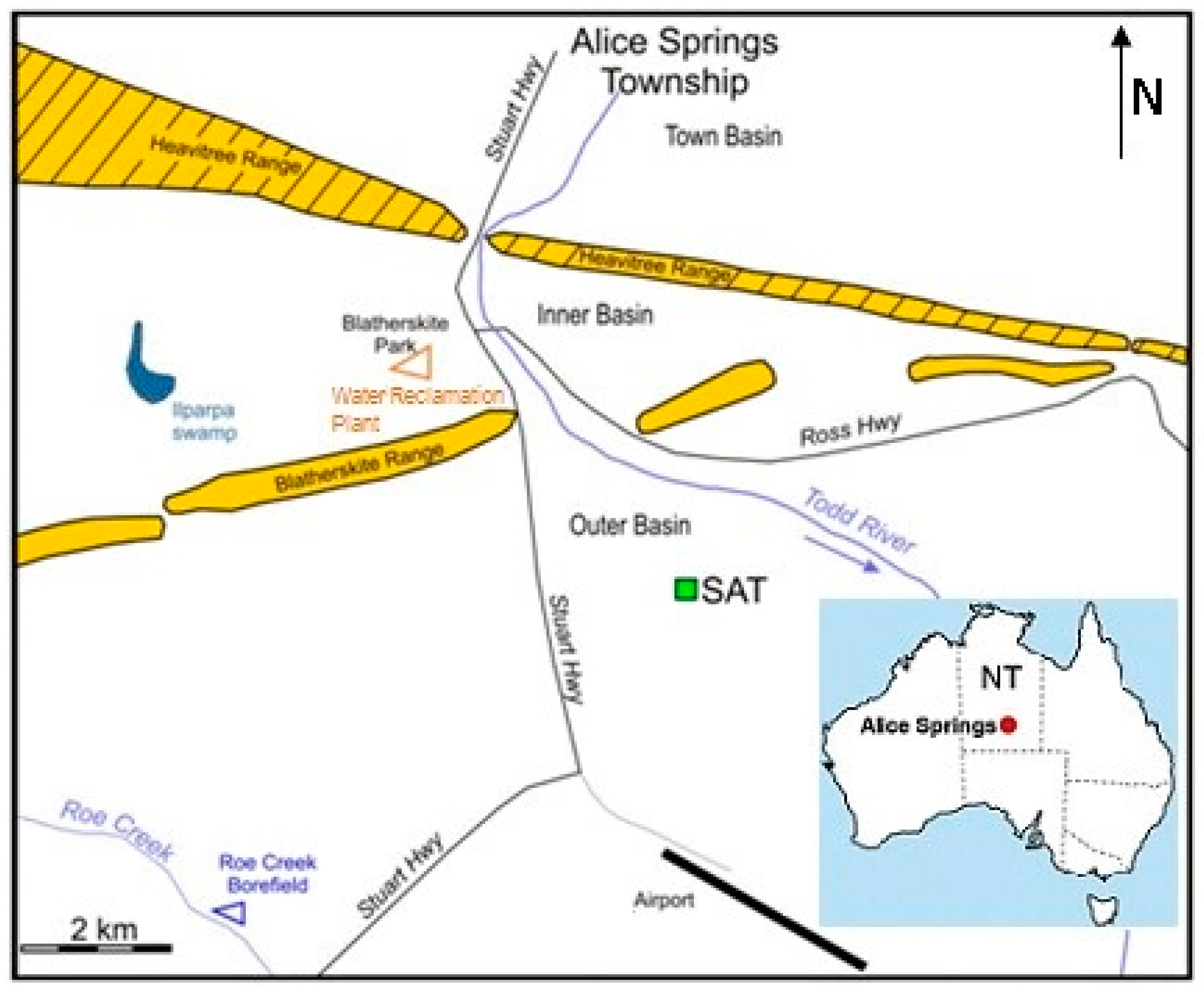
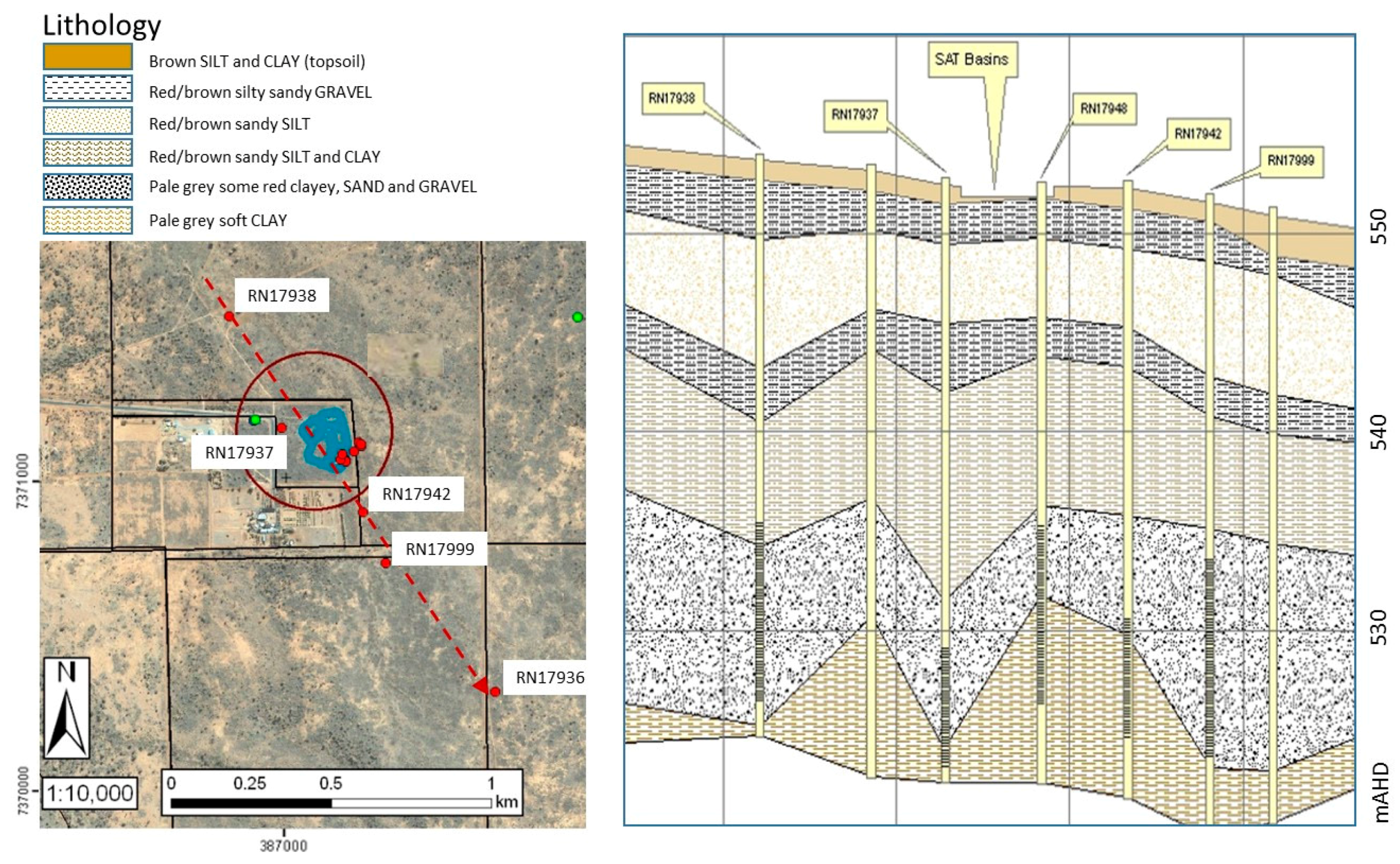
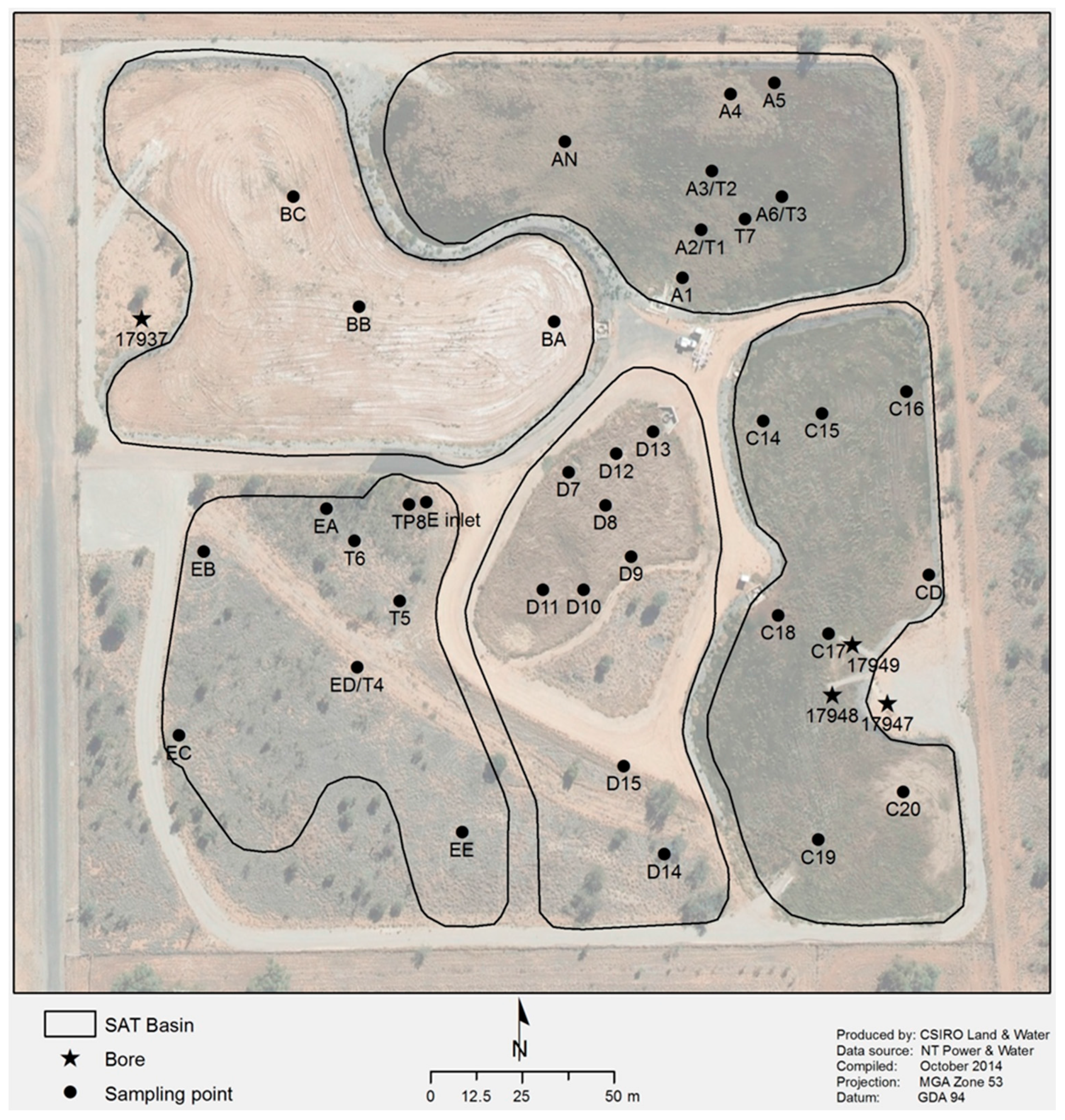
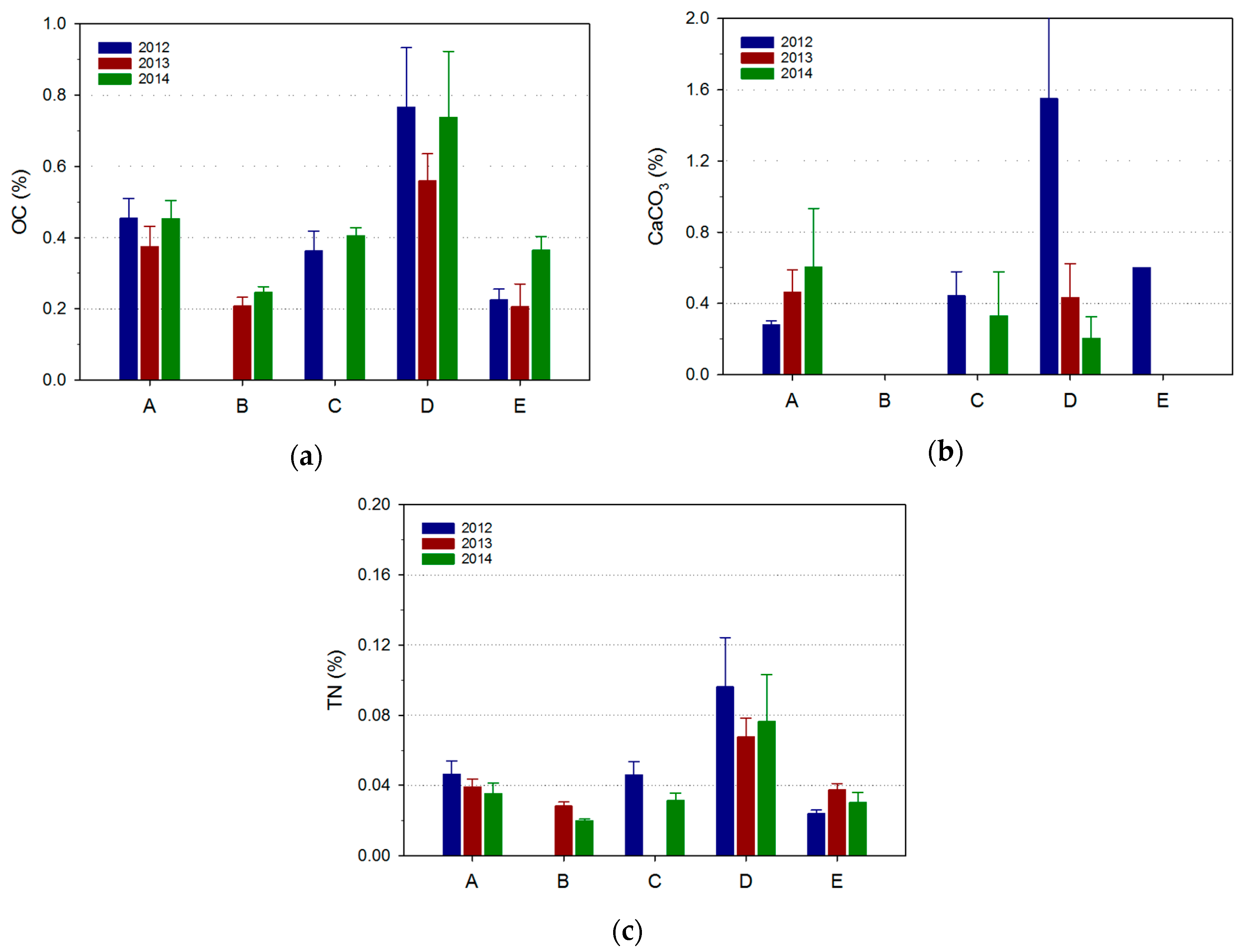
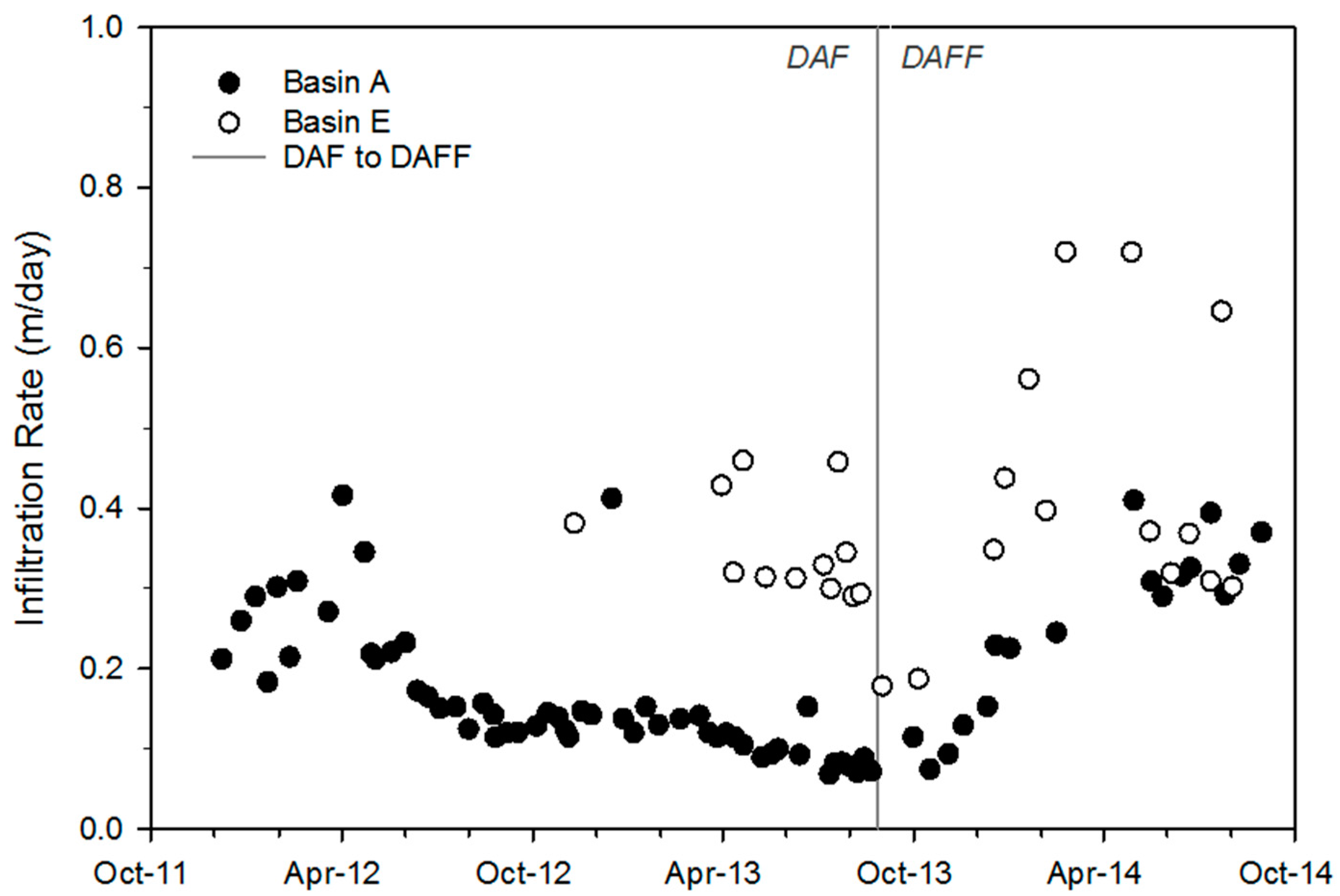
| All Units mg/L unless Specified | Ambient GW (n = 8) | DAF a (n = 23) | DAFF b (n = 12) | GW Adjacent to SAT Basins (n = 22) c |
|---|---|---|---|---|
| pH (-) | 7.4 ± 0.2 | 7.8 ± 0.1 | 7.7 ± 0.3 | 7.4 ± 0.15 |
| Alkalinity | - | 374 ± 30 | 275 ± 51 | 302 ± 16 |
| EC (µS/cm) | 2400 ± 700 | 1846 ± 157 | 1728 ± 143 | 1940 ± 403 |
| TSS | - | 9 ± 3 | <5 | - |
| Cl | 399 ± 139 | 271 ± 40 | 265 ± 28 | 304 ± 95 |
| SO4 | 508 ± 30 | 150 ± 40 | 168 ± 68 | 248 ± 140 |
| Total-N | 2.8 ± 2.1 | 16 ± 5 | 9.2 ± 4 | 9.3 ± 5.3 |
| Nitrate-N | 2.6 ± 2.0 | 1.1 ± 0.9 | 1.8 ± 1.2 | 9.4 ± 3.6 |
| Ammonium-N | 0.02 ± 0.01 | 12 ± 5.9 | 4.9 ± 4.8 | <1 |
| Phosphate-P | 0.05 ± 0.05 | 1.1 ± 0.5 | 0.4 ± 0.2 | 0.26 ± 0.27 |
| Soluble-P | 0.03 ± 0.03 | 0.8 ± 0.6 | 0.2 ± 0.2 | 0.04 ± 0.01 |
| BOD | - | 10 ± 12 | 1.1 ± 0.7 | - |
| DOC | 1.6 ± 0.5 | 9.4 ± 1.7 | 8.3 ± 1.6 | 1.9 ± 0.5 |
| Basin | A | B | C | D | E | |
|---|---|---|---|---|---|---|
| DAF | n | 57 | 24 a | 46 | 30 | 16 |
| Infiltration rate (m/day) | 0.17 ± 0.10 | 0.05 ± 0.06 | 0.14 ± 0.05 | 0.50 ± 0.20 | 0.55 ± 0.46 | |
| Drying Time (day) | 7 ± 3 | 17 ± 15 | 8 ± 5 | 12 ± 8 | 12 ± 8 | |
| Wetting Time (day) | 4 ± 1 | 7 ± 4 | 4 ± 1 | 2 ± 1 | 2 ± 1 | |
| DAFF | n | 17 | 16 | 14 | 15 | 19 |
| Infiltration rate (m/day) | 0.25 ± 0.10 | 0.20 ± 0.03 | 0.25 ± 0.10 | 1.0 ± 0.4 | 0.75 ± 0.52 | |
| Drying Time (day) | 10 ± 2 | 10 ± 8 | 10 ± 6 | 10 ± 5 | 11 ± 6 | |
| Wetting Time (day) | 3 ± 2 | 2 ± 1 | 3 ± 1 | 3 ± 1 | 3 ± 1 |
© 2017 by the authors. Licensee MDPI, Basel, Switzerland. This article is an open access article distributed under the terms and conditions of the Creative Commons Attribution (CC BY) license ( http://creativecommons.org/licenses/by/4.0/).
Share and Cite
Barry, K.E.; Vanderzalm, J.L.; Miotlinski, K.; Dillon, P.J. Assessing the Impact of Recycled Water Quality and Clogging on Infiltration Rates at A Pioneering Soil Aquifer Treatment (SAT) Site in Alice Springs, Northern Territory (NT), Australia. Water 2017, 9, 179. https://doi.org/10.3390/w9030179
Barry KE, Vanderzalm JL, Miotlinski K, Dillon PJ. Assessing the Impact of Recycled Water Quality and Clogging on Infiltration Rates at A Pioneering Soil Aquifer Treatment (SAT) Site in Alice Springs, Northern Territory (NT), Australia. Water. 2017; 9(3):179. https://doi.org/10.3390/w9030179
Chicago/Turabian StyleBarry, Karen E., Joanne L. Vanderzalm, Konrad Miotlinski, and Peter J. Dillon. 2017. "Assessing the Impact of Recycled Water Quality and Clogging on Infiltration Rates at A Pioneering Soil Aquifer Treatment (SAT) Site in Alice Springs, Northern Territory (NT), Australia" Water 9, no. 3: 179. https://doi.org/10.3390/w9030179
APA StyleBarry, K. E., Vanderzalm, J. L., Miotlinski, K., & Dillon, P. J. (2017). Assessing the Impact of Recycled Water Quality and Clogging on Infiltration Rates at A Pioneering Soil Aquifer Treatment (SAT) Site in Alice Springs, Northern Territory (NT), Australia. Water, 9(3), 179. https://doi.org/10.3390/w9030179








